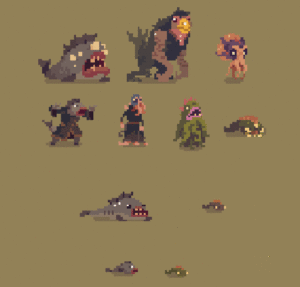
Crawl
Genre: Brawler/Dungeon Crawler…erm, Dungeon Brawler?
Developer: Powerhoof
Publisher: Powerhoof
Platforms: PC/Mac/Linux, Playstation 4, Xbox One, and Nintendo Switch
Review by Evan Maroun
Crawl is a devilishly clever, local multiplayer dungeon crawler. Take note of how I didn’t mention *co-op* in that sentence.
The whole concept of Crawl is almost akin to a game of Dungeons & Dragons except the singular role of the Dungeon Master is reversed and it’s without the turn-based play style. Sound strange? Let me explain. At the start of a game, there is an ominous narrated opening that leads into a fight between the four players. The last man standing becomes the hero, while everyone else spawns in as a spirit. The goal of the game as the hero is to reach level 10 by gaining XP in combat and entering a portal, which leads to one final boss encounter. However, on the way to level 10, all the other players operating as the spirits can do a number of things: possessing traps and statues, spawning in as Monsters, and overall, just making it a real pain for the hero. If a spirit manages to land a killing blow on the hero, then they take on the role of the hero, trying to slash and navigate their way through the dank depths of the 8-bit dungeon.
If you’re familiar with Halo multiplayer, it’s a similar idea to the Juggernaut gametype, but with some effective twists.

As players descend each floor, they are rewarded Wrath points, which are then used to upgrade their monster loadout. At the start of the game, you pick a deity of sorts to worship, which comes along with a perk and three different creatures. This acts as a loadout, as these are the monsters you will be able to spawn in as in spirit form. With the Wrath points you accumulate, you’re then able to evolve each of these monsters into a variety of deadlier versions, providing a layer of depth I was not initially expecting. Players can tailor their play style to whatever monsters they are most effective with while also having to take into consideration some serious pros and cons.
I wasn’t a fan of some monsters, but most of the choices include at least one monster that you’re not necessarily comfortable with. Part of this also has to do with the controls. They work quite well in terms of navigation, but when it comes to aiming certain spells and attacks, it can prove a little difficult. Strangely, I wouldn’t outright call this a negative. There is something in the clumsy way you throw out attacks that kind of adds to the charm of this party game, never quite feeling like you’re 100% precise allows for an element of randomness and a lot of playful exclamations like “UGHH-How did you get the killing blow?!” only to laugh it off, and continue onward on your quest to level 10.
While the spirits get monsters, the hero finds help in the wide variety of items available at shops that you’ll visit along your journey. These range from small conveniences like a better dodge roll to powerhouse weapons that have a chance to fire beams across the room. As you play the game and complete matches (which usually last around 30 minutes or so) more items become available, expanding the possibilities of each subsequent match.
This type of fast gameplay leads to a busy screen. When monsters and spells are flying across each randomly generated room of a dungeon, it can get hard to keep tabs on your character. There were a few times where a room would get so chaotic, I would have to stop and actively look for myself, or I possessed something by accident, which happened more than I would’ve liked. Having a trigger button indicate character position for times like this would’ve been convenient, but in the end, it’s a relatively minor gripe because before you know it, you’re back in the thick of it, trying to claim that highly coveted spot as the hero.

Recently I picked up Enter The Gungeon on Switch, a stellar bullet hell rogue-like game. In trying to use the joycons for multiplayer, it falls short because they tried to map so many buttons to a controller not suited for it — even with custom controls. Crawl doesn’t have this problem. I played with a friend on the Switch, each of us using a Joycon, and it works far better than I expected. I think that’s in itself an accomplishment, and it works because Crawl keeps it simple. Analog stick to move, one button to attack, and one for a special attack. It’s easy to pick up and doesn’t leave the controller feeling cramped, which a handful of Switch games fall victim to when it tries to utilize individual joycon play.
Verdict
Play it! Games like Crawl make me sorely miss the days of couch multiplayer. Today, where online play is a staple of many games, I feels like a lot of developers forgot how fun it is just to kick back with a couple friends and share the fun with someone right there next to you. There’s something to the experience that you can’t quite capture over a headset. For its low price point of $15, Crawl is a total steal and a very worthy addition to any game night.



